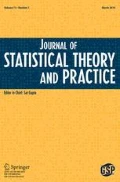Abstract
Using the D-optimality criterion, we show that resolution 3 fractional factorial designs perform as well as the complete factorial design in attribute-level best-worst choice experiments, assuming both that all attribute levels are equally attractive and that only main effects of attribute levels are to be used to explain the results.
Similar content being viewed by others
References
Bradley, R. A. 1955. Rank analysis of incomplete block designs: III. Some large-sample results on estimation and power for a method of paired comparisons. Biometrika, 42, 450–470.
Coast, J., T. N. Flynn, N. Lucy, K. Sproston, J. Lewis, J. J. Louviere, and T. J. Peters. 2008. Valuing the ICECAP capability index for older people. Social Sci. Med., 67, 874–882.
Coast, J., C. Salisbury, D. de Berker, A. Noble, S. Horrocks, T. J. Peters, and T. N. Flynn. 2006. Preferences for aspects of a dermatology consultation. Bri. J. Dermat., 155, 387–392.
Flynn, T., J. Louviere, T. Peters, and J. Coast. 2010. Using discrete choice experiments to under-stand preferences for quality of life. variance scale heterogeneity matters. Social Sci. Med., 70, 1957–1965.
Flynn, T. N., J. J. Louviere, T. J. Peters, and J. Coast. 2007. Best-worst scaling: What it can do for health care research and how to do it. J. Health Econ., 26, 171–189.
Huber, J., and K. Zwerina. 1996. The importance of utility balance in efficient choice designs. J. Marketing Res., 33, 307–317.
Knox, S. A., R. C. Viney, D. J. Street, M. R. Haas, D. G. Fiebig, E. Weisberg, and D. Bateson. 2011. What’s good and bad about contraceptive products? A best-worst attribute experiment comparing the values of women consumers and GP providers. Pharmacoeconomics. In press.
Marley, A. A. J., T. N. Flynn, and J. J. Louviere. 2008. Probabilistic models of set-dependent and attribute-level best-worst choice. J. Math. Psychol., 52, 281–296.
Pendergrass, R. N., and R. A. Bradley. 1960. Ranking in triple comparisons. In Contributions to probability and statistics, 331–351. Stanford, CA, Stanford University Press.
Pihlens, D. 2009. Personal communication. Technical report, University of Technology, Sydney.
Potoglou, D., P. Burge, T. Flynn, A. Netten, J. Malley, J. Forder, and J. E. Brazier. 2011. Best-worst scaling vs. discrete choice experiments: An empirical comparison using social care data. Social Sci. Med., 72, 1717–1727.
Street, D. J. 2006. Orthogonal main effect plans. In Handbook of combinatorial designs, 2nd ed., ed. C. Colbourn and J. Dinitz, 547–549. Boca Raton, FL, Chapman & Hall/CRC Press.
Street, D. J., and L. Burgess. 2007. The construction of optimal stated choice experiments: Theory and methods. New York, NY, Wiley.
Author information
Authors and Affiliations
Corresponding author
Rights and permissions
About this article
Cite this article
Street, D.J., Knox, S.A. Designing for Attribute-Level Best-Worst Choice Experiments. J Stat Theory Pract 6, 363–375 (2012). https://doi.org/10.1080/15598608.2012.673900
Received:
Accepted:
Published:
Issue Date:
DOI: https://doi.org/10.1080/15598608.2012.673900


